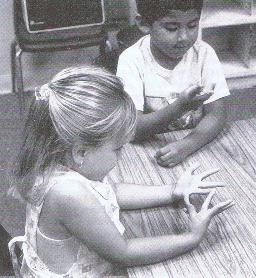Finger Counting

|
(A photo came from Carpenter's Children's Mathematics. The mentioning of the book is by no means intended as a recommendation.)
There is no escaping the fact that children learn to count by counting fingers on one's hand. Some do that longer than others but all do. The manner of finger counting differs from culture to culture. In some places, they start with the thumb, in others with a little finger. Sometimes, the fingers are getting folded, and sometimes they are straightened up. However it is done, finger counting is an important activity that has a scientific name of dactylonomy (From Greek dactilus - finger, and nomos - law, area of knowledge.)
Indeed, for children fingers are virtually inseparable from numbers. [Ginsburg, p. 42] tells of an episode when a five year old child riding a ski lift let go of her skis just to show the hand with five fingers as an answer about her age. [Dehane, p. 93] writes that "All children spontaneously discover that their fingers can be put into one-to-one correspondence with any set of items. One merely has to raise one finger for the first item, two for the second, and so on."
Plain counting on fingers is not the only and certainly not the most efficient use of the ubiquitous facility. Even in ancient time, in order to reach larger numbers, people resorted to counting on knuckles. In modern times, with a higher degree of sophistication, one may use the fingers to substitute for binary digits, thus attaining a formidable count of 31 (= 111112) on one hand and the count of 1023 (= 11111111112) on two.
There is a relatively straightforward way of counting to 10 on one hand and to 100 on two. This is illustrated with the pictures below:
 |  |  |  |  | |
| one | two | three | four | five |
|---|
 |  |  |  | |
| six | seven | eight | nine |
|---|
A folded fist may stand for 10 if you do not plan to use the second hand, or for 0 if you do:
 | |
| ten/zero |
|---|
The second hand is used in the same manner but for counting 10s:
  |   | |
| ten | eleven |
|---|
  |   | |
| twenty six | fifty five |
|---|
References
- T. P. Carpenter et al, Children's Mathematics - Cognitively Guided Instruction, NCTM, 1999
- S. Dehaene, The Number Sense, Oxford University Press, 1999
- H.P.Ginsburg, Children's Arithmetic, 2nd edition, pro-ed, 1989
Related material
| |
|
| |
|
| |
|
| |
|
| |
|
| |
|
| |
|Contact| |Front page| |Contents| |Arithmetic| |Up|
Copyright © 1996-2018 Alexander Bogomolny73497101
